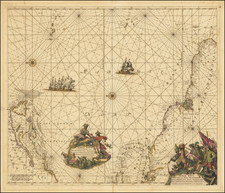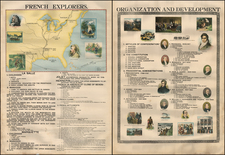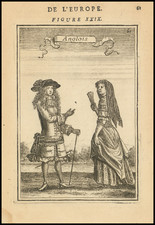are early English sea chart of the Atlantic, published in London by Jeremiah Seller and Charles Price.
The map is one of the earliest sea charts published in England to illustrate what would become known as the Triangle Trade, which involved the transport of slaves from Africa to the Caribbean and North America, which were sold, with the money used to purchae raw goods (sugar, rum, molasses; tobacco and hemp), which were in turn transported to Europe and sold, before beginning again. The trade took adavantage of the prevailing ocean currents, which made the triangular route more adventageous than simply an "out and back" route.
The map is a reduced version of a 4 sheet wall map of the same region, published by Thornton, Fisher, Colson & Atkinson (Burden #506).
The map includes part of North and South America, western Europe and southern England. The cartouche, placed in the central Africa, contains two figures blowing horns. Another cartouche appears in South America with two natives and two animals surround the scale. The compass rose radiates rhumb lines to all four continents.
The present example would seem to be the second state, of the map, with the names Jeremiah Seller and Charles Price erased. The first state has the name "Jer Seller & Cha Price" in the cartouche in Africa.
One of the most curious features of the map is the naming of "Batlemore" between Maryland and Chesapeake B. The Maryland colonial General Assembly created the Port of Baltimore at Locust Point in 1706 for the tobacco trade. The Town of Baltimore was founded on July 30, 1729, and is named after Lord Baltimore, who was the first Proprietary Governor of the Province of Maryland.
This may in fact be the earliest appearance of the name on a printed map.
Charles Price (1679?-1733) was an engraver, instrument maker, and mapseller.
Price had been apprenticed to John Seller, famous mapmaker and father to Charles’ business partner, Jeremiah. In fact, Jeremiah and Charles were made free of the Merchant Taylors Guild on the same day, September 1, 1703. The two were already working together by then.
After breaking off with Seller, Price worked with John Senex (1705-10) and George Wildey (1710-13). He was still working in the 1720s, but was in Fleet Prison in 1731 for debt and died two years later.
Jeremiah Seller (1671-?) was the second son of prominent London mapmaker John Seller. He inherited two-thirds of the business upon his father’s death in 1697. From 1700-5 Seller worked in partnership with Charles Price. In 1705, Jeremiah lost the family contract to supply instruments to the Royal Navy, which led to the dissolution of his partnership with Price. Seller left the map trade in that year, passing his stock to Richard Mount and Thomas Page.









![Charte von den Vereinigten Staaten von Nord=America mit Luisiana Prag 1818 [Rare Florida inset]](https://storage.googleapis.com/raremaps/img/small/72217.jpg)



![[Caribbean]](https://storage.googleapis.com/raremaps/img/small/85443.jpg)
![Pascaart vertoonende de zeecusten van Chili, Peru, Hispania Nova, Nova Granada, en California…. [Early New Zealand Inset]](https://storage.googleapis.com/raremaps/img/small/65168.jpg)